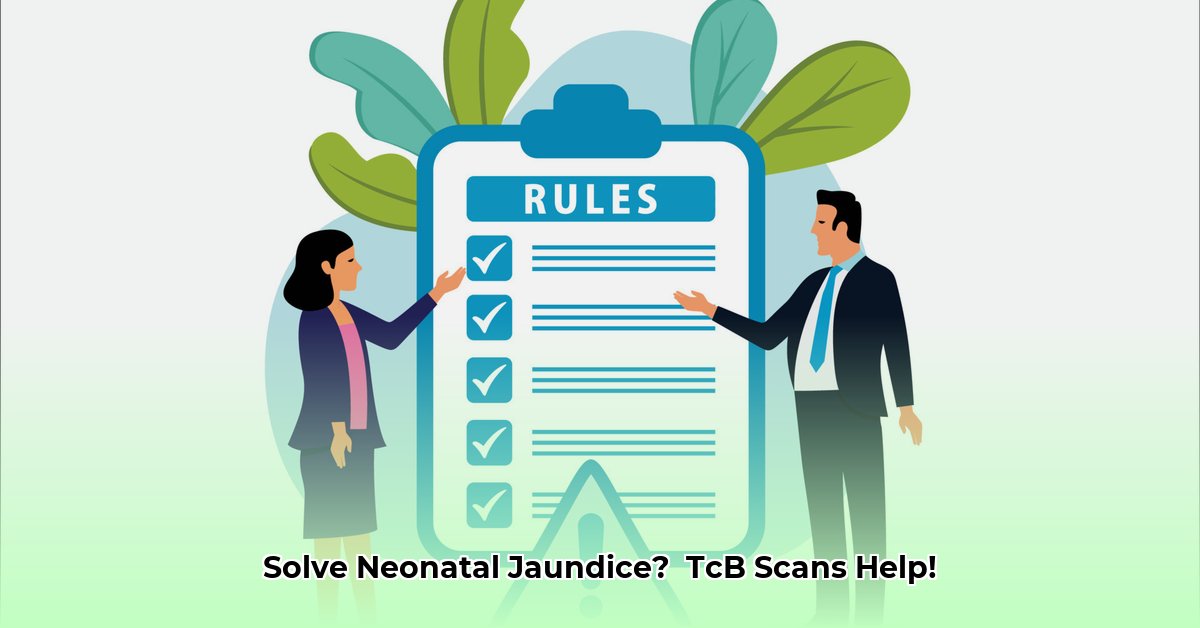Ensuring newborns avoid dangerously high bilirubin levels (hyperbilirubinemia) is crucial. This guide focuses on using transcutaneous bilirubinometry (TcB) to quickly and easily screen for jaundice. We’ll cover correct TcB usage, tips for optimal readings, and important considerations for accuracy and integration into routine care. Packed with practical advice and real-world examples, this resource empowers healthcare providers to make informed decisions for their patients. Whether you’re experienced or new to TcB, this guide provides the knowledge needed to effectively manage neonatal jaundice. For more on interpreting TcB scans, see this helpful guide: TcB Scan Interpretation.
TcB Scan Best Practices: Accuracy and Newborn Safety
TcB scans offer a non-invasive method for jaundice screening, reducing the need for blood draws. However, maximizing their effectiveness requires understanding proper usage and accurate interpretation. This guide outlines best practices for TcB scans to ensure newborn safety.
Understanding Transcutaneous Bilirubinometry (TcB): A Non-Invasive Screening Tool
A TcB device shines light on a baby’s skin to measure bilirubin levels. Bilirubin, a yellow substance, accumulates when a newborn’s liver isn’t fully processing it. Excessive bilirubin leads to jaundice, which can be serious if untreated. TcB scans provide quick, painless estimates of bilirubin levels without requiring blood samples, making them ideal for jaundice detection and monitoring. It’s critical to remember that TcB provides an estimate, not a definitive diagnosis.
Challenges in Interpreting TcB Results: Cutoff Points and Standardization
A significant challenge with TcB is the lack of a universally accepted cutoff point indicating the need for a blood test. Guidelines vary, with some using age- and weight-based charts, while others focus on proximity to treatment thresholds (e.g., phototherapy). This inconsistency can lead to differing approaches among healthcare providers. Standardized cutoff points are essential for consistent neonatal care.
Factors Influencing TcB Accuracy: Gestational Age, Skin Condition, and Device Calibration
TcB accuracy depends on the baby’s gestational age, the specific TcB machine used, device calibration, and even skin condition. Consequently, a “one-size-fits-all” approach is ineffective. Individualized assessment is crucial, emphasizing the importance of well-defined guidelines.
Balancing Sensitivity and Specificity in Jaundice Screening
Effective jaundice screening requires a balance: high sensitivity to identify babies needing treatment (minimizing false negatives) and high specificity to avoid unnecessary blood tests (reducing false positives). This balance is crucial for newborns. Robust guidelines are essential for clinicians navigating this delicate balance to deliver optimal care.
Practical Steps for Reliable TcB Screening: Protocols and Training
Implementing effective TcB screening involves key steps to ensure accuracy and reliability:
- Equipment Selection and Maintenance: Choose validated TcB devices, ensuring regular calibration and maintenance.
- Age-Appropriate Guidelines: Utilize decision rules that account for gestational age. Select well-supported nomograms (charts) for accurate assessment.
- Risk Factor Consideration: Recognize that premature birth, certain medical conditions, and family history can elevate jaundice risk. Consider the comprehensive clinical picture.
- Staff Training and Competency: Ensure personnel understand proper device usage through regular training and competency checks.
- Clear Protocols: Establish clear, accessible protocols for confirmatory blood tests, promoting consistent application.
- Data Tracking and Refinement: Regularly review TcB results to identify patterns and improve accuracy. Continuous quality improvement is essential.
Weighing the Pros and Cons of TcB: A Comprehensive Overview
| Feature | Advantages | Disadvantages |
|---|---|---|
| Procedure | Non-invasive, quick, easy bedside use. | Requires training; factors like skin tone and device calibration can affect results. |
| Cost | Potentially cost-effective by reducing blood tests. | Initial equipment investment. |
| Efficiency | Streamlines screening and workflow. | Accuracy can vary. |
| Patient Comfort | Minimal discomfort. | Potential for minor skin irritation; some prep may be needed. |
The Future of TcB Guidelines: Advancements and Updates
Research continuously improves TcB technology. Future guidelines are likely to incorporate sophisticated data analysis and advanced algorithms for enhanced accuracy. Periodic updates are crucial to maintain effectiveness, ensuring the safest and most efficient approach to newborn jaundice management.
How to Choose the Best Transcutaneous Bilirubinometry (TcB) Decision Rule
Key Takeaways:
- TcB offers a quick, non-invasive jaundice screening method, reducing blood test requirements and improving care.
- Accuracy depends on the decision rule, device, gestational age, and demographic factors.
- No single perfect rule exists; selection must balance correctly identifying babies needing treatment and avoiding unnecessary interventions.
- Skin color and TcB device significantly affect results.
- Further research is needed to address variations.
Understanding TcB Decision Rule Challenges: Variability and Considerations
Selecting the right TcB decision rule is essential for effective neonatal jaundice screening. Different rules have varying strengths and weaknesses based on implementation and patient factors. The ideal rule balances sensitivity and specificity.
TcB accuracy varies based on the chosen rule and device. Therefore, informed consideration is crucial.
Influencing Factors: Device Variability and Demographics
Consider the following when administering a TcB scan:
- Device Variability: Accuracy varies among TcB devices. Are you using a BiliChek, JM-103, or another model?
- Patient Demographics: Skin tone and gestational age affect TcB readings. Darker skin tones can underestimate bilirubin levels.
- Institutional Context: Hospital resources shape the choice. Are there sufficient resources for follow-up testing?
- Evidence-Based Guidelines: Leverage available evidence and established guidelines.
Step-by-Step Guide to Rule Selection: Resources and Monitoring
- Assess available resources: Evaluate the TcB devices. This affects the available decision rules.
- Review relevant literature: Consult recent studies. Focus on studies that consider the devices you’ll use and address patient demographic variations.
- Develop an institutional-specific algorithm: Adjust existing decision rules based on evidence and your hospital’s context.
- Implement and monitor: Regularly monitor performance and adjust as necessary.
- Water Wheel Electric Generator Provides Free Home Electricity - December 15, 2025
- Choosing the Right Portable Hydro Turbine for Your Needs - December 14, 2025
- Best Portable Hydro Generators for Off-Grid and Outdoor Power - December 13, 2025
















